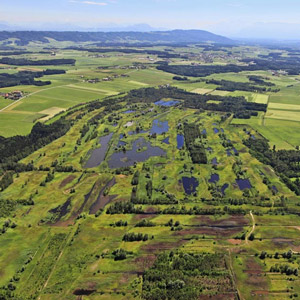Magazine | Voyages
Le Weidmoos : un retour de la Nature accompagné par l’Homme

Vue aérienne du Weidmoos, dans les Préalpes autrichiennes : à l’arrière-plan, les Alpes.Photographie : Klaus Leidorf
Introduction
Jusqu’au XVIIIème siècle, d’immenses tourbières s’étendaient dans les Préalpes autrichiennes. C’était en particulier le cas du Weidmoos, situé à environ 20 km au nord de la ville de Salzbourg, sur les communes de Lamprechtshausen et de St. Georgen. Les activités d’extraction de la tourbe l’ont transformé en une friche industrielle.
Cette exploitation a cessé en l’an 2000, et peu à peu la Nature a repris le dessus, créant une mosaïque d’habitats colonisés par de nombreuses espèces de plantes et d’animaux. En particulier, des oiseaux rares en Autriche s’y sont installés, comme la Gorgebleue à miroir blanc.
En raison de son nouvel intérêt ornithologique, le Weidmoos a été désigné en 2001 comme « réserve de l’Union Européenne » (directive 79/409/CEE du Conseil) et a été inscrit dans le réseau Natura 2000.
Afin d’empêcher que la zone ne se transforme peu en peu en un boisement uniforme, des mesures ont été prises entre 2003 et 2007 dans le cadre d’un projet LIFE intitulé « Gestion de l’habitat dans la réserve de Weidmoos ». Ses objectifs étaient de maintenir la diversité des milieux naturels et d’ouvrir la zone aux visiteurs.
Nous remercions Bernhard Riehl, le responsable du projet, pour nous avoir aidés à rédiger cet article.
Abstract
The Weidmoos is an old area of peat bog about 20 km north of the city of Salzburg, close to the boundary between Salzburg and Upper Austria in the communes of Lamprechtshausen and St. Georgen.
It was originally part of an extensive bog area, but peat cutting activities have turned it into an industrial landscape. The end of peat cutting in the year 2000, however, signalled the emergence of a fascinating new and completely different habitat.
The area has become a haven for many species of birds which are now rare in Europe. Because of its variety of bird life, the Weidmoos was in 2001 designated an « EU bird reserve » (Council Directive 79/409/EEC) and became part of the European « NATURA 2000 » network.
But the impact of peat cutting has been such that the Weidmoos could not simply be left to itself. After the former moor had been drained, it would have soon become an area of monotonous woodland unless action would be taken. This would have meant that many of the bird species would again have lost the home they have recently found.
Between 2003 and 2007 the LIFE project « Habitat management in the SPA Weidmoos » took active steps to make the habitat of these endangered bird species accessible to visitors and ensure its long-term preservation.
Poursuivez la lecture de cet article, en vous abonnant dès maintenant !
Découvrez les Archives d’Ornithomedia.com
Pour seulement 10,00 €TTC/an (ou 6,00 € les 6 mois)
Profitez de plusieurs centaines d’articles en accès illimité et sans aucun engagement.
Compléments
À lire sur le web
Des informations pratiques sont disponibles sur www.weidmoos.at
Ouvrages recommandés
- Le guide Ornitho de L. Svensson et al
- Austria (Globetrotter Travel Map) de Globetrotter (Carte – 25 juillet 2008)
- Birds of Austria de Frederic P. Miller, Agnes F. Vandome et John McBrewster
Source
Weidmoos (2011). LIFE Project. Habitat Management in the Weidmoos Bird Reserve.




Aucun commentaire sur ce sujet
Participer à la discussion !